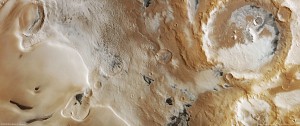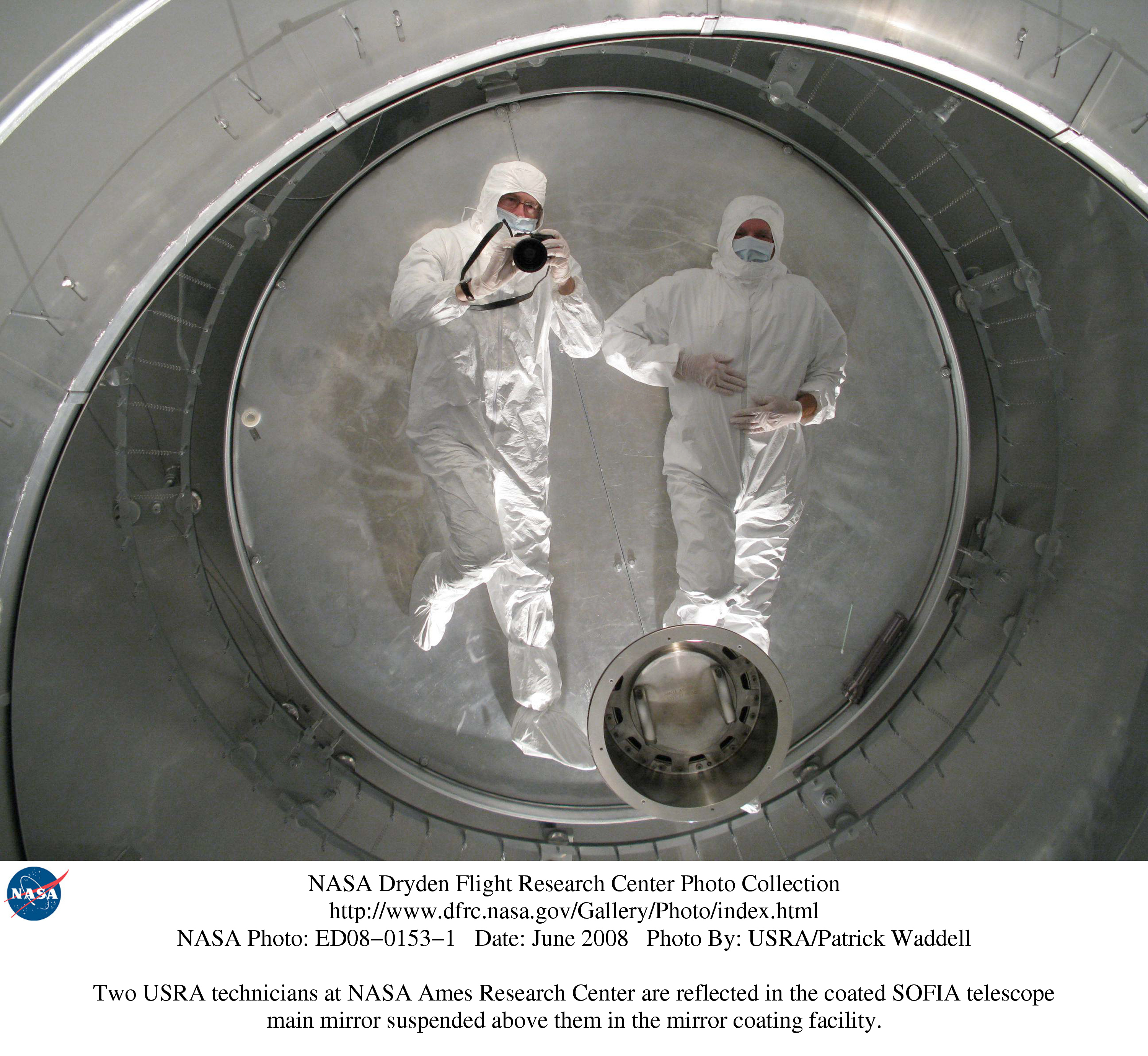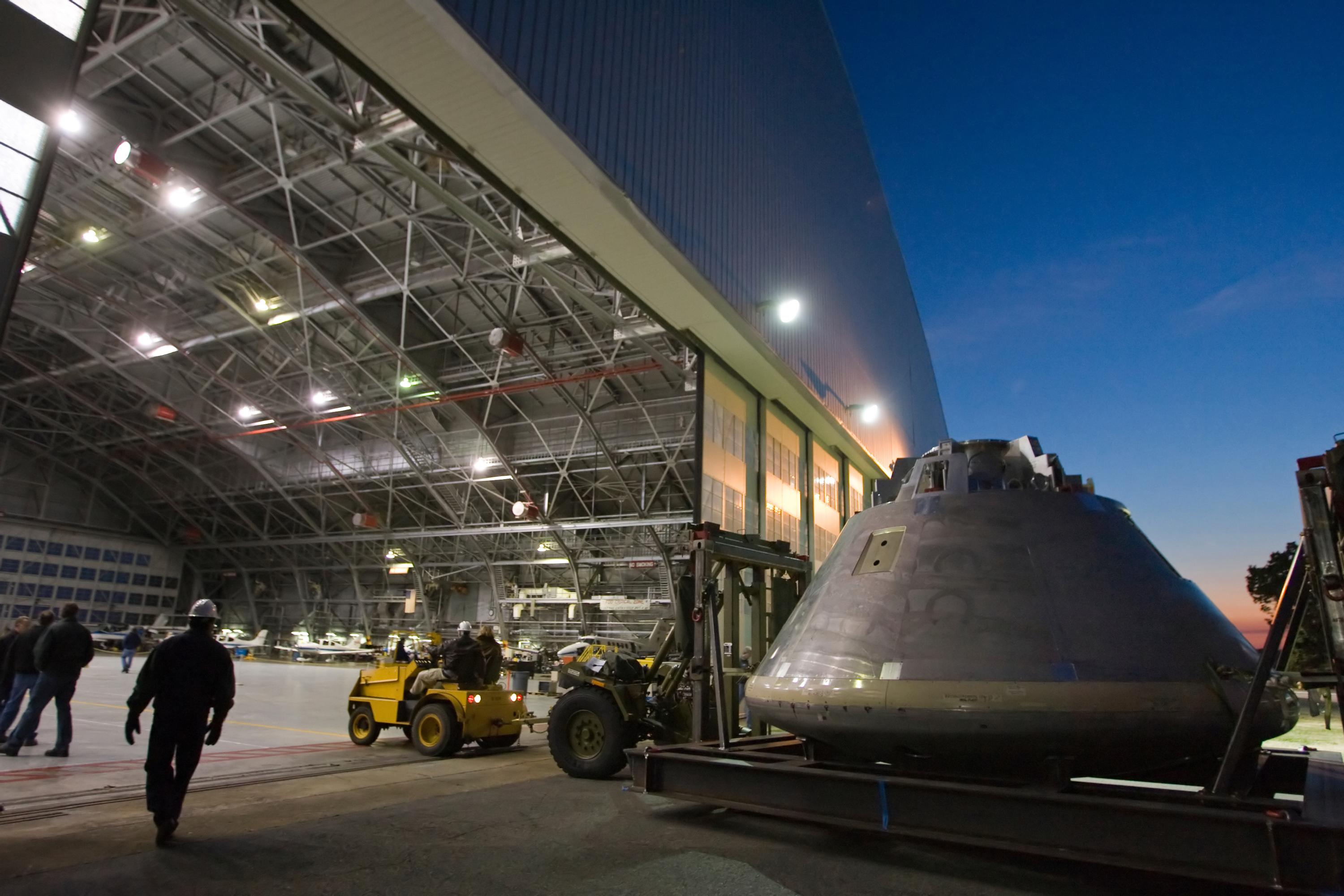
By Kerry Ellis
The pursuit of space science does more than reveal new facts and spawn new theories about the universe and our place in it.

Perspective view of Hebes Chasma obtained by the high-resolution stereo camera (HRSC) on ESA’s Mars Express spacecraft.
Photo Credit: ESA/DLR/FU Berlin (G. Neukum)
It also provides common ground for international collaboration. Scientists all over the world share their passion for investigating and learning about other planets, and Mars in particular draws attention. But why are we so eager to keep exploring our neighbor in the solar system? And how do scientists scattered across the world collaborate on one mission to a destination millions of miles away?
Many of the missions flying in space today begin with a scientist somewhere asking a question. Agencies like NASA and the European Space Agency (ESA) provide the means to answer those questions, and those scientists frequently join the resulting projects as principal investigators. When several scientists ask different questions about the same place, missions offer a way for a variety of experiments to catch the same ride into space.
The ESA’s Mars Express orbiter, Europe’s groundbreaking first planetary mission, involved principal investigators from Germany, Sweden, Italy, and France and contributions from Japan, the United States, and Russia. It gave a ride to seven exploratory instruments, and while each instrument measures something different about the red planet, they are all seeking to answer the same questions: What happened on Mars? And could it happen on Earth?
Seeking Answers Together
To obtain cohesive answers, principal investigators collaborate with each other and communicate continuously among themselves and with ESA. Each principal investigator works with a team of scientists and engineers on his or her instrument and coordinates with many scientific groups in different countries. The high-resolution stereo camera (HRSC) team, for example, includes nine co-investigators from across the United States, at Arizona State University, Brown University, the Jet Propulsion Laboratory, and the U.S. Geological Survey.
Before launching Mars Express, the principal investigators also had to coordinate with the ESA engineers building the orbiter and lander. Since the mission is currently in operation around Mars, they keep in close contact with each other through weekly teleconferences and many meetings coordinated by the ESA Mars Express project scientist. To plan their observations, they are also in constant contact with the ESA science operations center.

Apollinaris Patera is an ancient shield volcano measuring approximately 180 km by 280 km at its base and rising to a maximum of 5 km above the surrounding terrain. The image also shows the terrain partly covered by thin, diffuse clouds indicated by bluish-tinted areas.
Photo Credit: ESA/DLR/FU Berlin (G. Neukum)
The scientists work closely with their fellow principal investigators, coordinating when each instrument will make its observations or discussing how data obtained from one instrument could benefit a sister experiment. Most of the principal investigators had worked together on the failed ’96 Russian mission to Mars, so they came prepared to meet with old colleagues and improve their instruments for the ESA mission. Sometimes their conversations helped evolve the design of an instrument as it was being built to ensure better coordination with the other experiments on the mission.
“The concept of our experiment evolved substantially from these discussions,” said Vittorio Formisano, principal investigator for the planetary Fourier spectrometer (PFS). “We attempted different solutions to different aspects in the beginning, and when we passed from the Russian mission to the ESA proposal, there was a strong mass reduction requirement. We decreased the experiment mass by 12 kg, reorganizing the international collaborations and contributions.”
Even after Mars Express launched, scientists continue to adapt their observations as they receive new information from their experiments. These discoveries have changed the course of the mission as it is operating.
“Most discoveries were made along the course of the mission, without being predicted, concerning the composition of both the surface and the atmosphere—clouds in particular,” said Jean-Pierre Bibring, principal investigator for the visible and infrared mineralogical mapping spectrometer (OMEGA). “Consequently, we modified our observational strategy accordingly, trying to coordinate with the other principal investigators as much as we could.”
These discoveries go beyond informing the mission during its journey; they also help shape future missions to Mars. “Earlier on, most of our understanding of Mars surface structures and evolution came from the interpretation of optical images and altimetry data,” said Bibring. “The study of the surface minerals with new tools like OMEGA is providing us with a new fundamental set of information to reveal, for instance, the history of liquid water on the red planet. We have discovered the presence of hydrated minerals—called phyllosilicates—which show that water must have flowed abundantly in the early history of Mars. This opens the possibility that conditions for life to grow may have existed, as on Earth. Sites featuring such minerals could be favored targets for future missions, as they would be among the most likely to contain microfossils if ever life once emerged on Mars.”
To obtain these findings, Bibring worked in tandem with the other principal investigators at all levels, from programmatic to scientific. “We had to coordinate observation scheduling and data sharing, and we even exchanged co-investigators and students,” he said.
Working closely with the OMEGA instrument is the PFS instrument, which studies the atmosphere by measuring its composition and temperature and the way it varies with altitude. PFS obtains these measurements by studying the sunlight absorbed by molecules and the infrared radiation they emit. “OMEGA has a lower spectral capability but can produce images, unlike PFS,” said Formisano. “PFS has a very high spectral resolution, and it identified traces of methane in the atmosphere from orbit for the first time. Methane is another important element to track when looking for traces of life.” OMEGA, PFS, HRSC, the ultraviolet and infrared atmospheric spectrometer (SPICAM), the energetic neutral atoms analyzer (ASPERA), and the other instruments are providing a complete picture of what makes up Mars’s atmosphere and surface, and if water could have existed there for a prolonged period of time.
Mars Express’s collaborative successes have extended beyond its primary mission. The spacecraft helped NASA’s Mars Phoenix mission by capturing and relaying data during the lander’s entry, descent, and landing.
Learning About Mars—and Earth
“We think of Mars as a sister of Earth,” said Martin Pätzold, principal investigator for the radio science experiment (MaRS). “It could well have harbored life in its early years. It is therefore very interesting to look closely at the similarities and differences between our two planets, from a geophysical point of view, analyzing its upper atmosphere and the effect of the solar wind on it, the roughness of the planet’s surface, and even its interior by measuring the effects of Mars’s gravity field on the spacecraft velocity.” Among other things, the MaRS experiment also allowed the most precise measurement ever of the mass of the Martian moon Phobos.

Promethei Planum, an area seasonally covered with a layer of ice more than 3,500 m thick in the Martian south polar region, photographed by the HRSC.
Photo Credit: ESA/DLR/FU Berlin (G. Neukum)
Jean-Loup Bertaux, principal investigator for SPICAM, is testing the theory that more water vapor in the atmosphere means less ozone. “This could have vital consequences for Earth because we have both ozone and very little water vapor in our stratosphere,” he said. “With changes in our climate, our water vapor levels could increase drastically in the stratosphere, and this may be developing a new threat for ozone. On Mars, we can check our theory on the chemistry of water vapor and ozone, and since chemical reactions are the same on both planets, we would thereby learn more about our planet’s possible future.”
The greatest ambition of MARSIS, led by Giovanni Picardi and Jeffrey Plaut, is to find liquid water still existing on Mars, “because this is the basis of life, both in scientific thought and also according to the Greek philosopher Eraclito’s ancient principle of ‘panta rei’—everything flows!” Picardi said. MARSIS is looking deep below Mars’s surface and has already identified, for the first time ever, ice-water deposits underground.
Future Exploration
Mars Express launched successfully in June 2003 and was originally planned to run for one Martian year (687 days). The mission has already been extended twice, and it is now funded for operation until May 2009. Its success, despite the loss of its Beagle 2 lander, represents Europe’s first foray into planetary exploration and paved the way for ESA’s Venus Express, which launched in 2005. The collaborative discoveries of the Mars Express principal investigators, combined with those of space scientists across the world, help create a cohesive picture of the solar system’s—and Earth’s—evolution and the unique circumstances required to support life. Their discoveries are also informing future exploration of Mars.
Stas Barabash, principal investigator for the ASPERA instrument that is studying how particles in the atmosphere interact with solar wind, is building on the data returned by Mars Express. By studying ionized gases at the boundary between Martian atmosphere and space, Barabash says, “We are studying just how quickly water vapor and other gases are being lost from Mars. Ultimately, these measurements could help us decide whether Mars supported conditions suitable for life in the past.”
Gerhard Neukum, principal investigator for the HRSC, is also confident his 3–D measurements, mapping of Mars’s surface, and study of volcanic and glacial activity could help us understand the planet’s evolution as well as aid future exploration efforts. “In a way, we are investing in the future generations of scientists to come,” he said. “We are uncovering a whole new world in 3–D, showing exactly what Mars looks like as though the images were taken from a low-flying airplane. And, who knows, we may be preparing the ground for somebody to go to Mars one day.”








